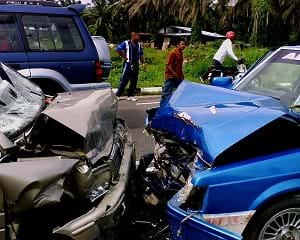Quick Look
Grade Level: 8 (7-9)
Time Required: 45 minutes
Lesson Dependency: None
Subject Areas: Physical Science, Physics
NGSS Performance Expectations:

| HS-PS2-2 |

Summary
Students learn about the physical force of linear momentum — movement in a straight line — by using the associated activities to investigate collisions. They learn an equation that engineers use to describe momentum. Students also investigate the psychological phenomenon of momentum; they see how the "big mo" of the bandwagon effect contributes to the development of fads and manias, and how modern technology and mass media accelerate and intensify the effect.Engineering Connection
Whether it is a truck, a washing machine or a wind turbine, engineers commonly design products that move, so momentum is an important part of their design considerations. Over the years, engineers have been successful in using their knowledge of the force-momentum relationship to make vehicles safer in collisions. For example, vehicle front ends are especially designed to crumple, as a protective measure to reduce the forces felt by the occupants. Car safety seats are also designed to protect small children from accident forces.
Learning Objectives
After this lesson, students should be able to:
- Explain how linear momentum depends on both mass and velocity.
- Differentiate between elastic and inelastic collisions.
- Describe why modern cars are safer in collisions than older ones.
- Relate linear momentum to its equation.
- Explain Newton's third law of motion.
Educational Standards
Each TeachEngineering lesson or activity is correlated to one or more K-12 science,
technology, engineering or math (STEM) educational standards.
All 100,000+ K-12 STEM standards covered in TeachEngineering are collected, maintained and packaged by the Achievement Standards Network (ASN),
a project of D2L (www.achievementstandards.org).
In the ASN, standards are hierarchically structured: first by source; e.g., by state; within source by type; e.g., science or mathematics;
within type by subtype, then by grade, etc.
Each TeachEngineering lesson or activity is correlated to one or more K-12 science, technology, engineering or math (STEM) educational standards.
All 100,000+ K-12 STEM standards covered in TeachEngineering are collected, maintained and packaged by the Achievement Standards Network (ASN), a project of D2L (www.achievementstandards.org).
In the ASN, standards are hierarchically structured: first by source; e.g., by state; within source by type; e.g., science or mathematics; within type by subtype, then by grade, etc.
NGSS: Next Generation Science Standards - Science
-
For any pair of interacting objects, the force exerted by the first object on the second object is equal in strength to the force that the second object exerts on the first, but in the opposite direction (Newton's third law).
(Grades 6 - 8)
More Details
Do you agree with this alignment?
-
Newton's second law accurately predicts changes in the motion of macroscopic objects.
(Grades 9 - 12)
More Details
Do you agree with this alignment?
-
Momentum is defined for a particular frame of reference; it is the mass times the velocity of the object.
(Grades 9 - 12)
More Details
Do you agree with this alignment?
| NGSS Performance Expectation | ||
|---|---|---|
|
HS-PS2-2. Use mathematical representations to support the claim that the total momentum of a system of objects is conserved when there is no net force on the system. (Grades 9 - 12) Do you agree with this alignment? |
||
| Click to view other curriculum aligned to this Performance Expectation | ||
| This lesson focuses on the following Three Dimensional Learning aspects of NGSS: | ||
| Science & Engineering Practices | Disciplinary Core Ideas | Crosscutting Concepts |
| Use mathematical representations of phenomena to describe explanations. Alignment agreement: | Momentum is defined for a particular frame of reference; it is the mass times the velocity of the object. Alignment agreement: If a system interacts with objects outside itself, the total momentum of the system can change; however, any such change is balanced by changes in the momentum of objects outside the system.Alignment agreement: | When investigating or describing a system, the boundaries and initial conditions of the system need to be defined. Alignment agreement: |
Common Core State Standards - Math
-
Fluently add, subtract, multiply, and divide multi-digit decimals using the standard algorithm for each operation.
(Grade
6)
More Details
Do you agree with this alignment?
-
Fluently divide multi-digit numbers using the standard algorithm.
(Grade
6)
More Details
Do you agree with this alignment?
-
Use variables to represent quantities in a real-world or mathematical problem, and construct simple equations and inequalities to solve problems by reasoning about the quantities.
(Grade
7)
More Details
Do you agree with this alignment?
-
Solve linear equations in one variable.
(Grade
8)
More Details
Do you agree with this alignment?
International Technology and Engineering Educators Association - Technology
-
Explain how knowledge gained from other content areas affects the development of technological products and systems.
(Grades
6 -
8)
More Details
Do you agree with this alignment?
State Standards
Colorado - Math
-
Solve real-world and mathematical problems involving the four operations with rational numbers.
(Grade
7)
More Details
Do you agree with this alignment?
-
Solve linear equations and inequalities in one variable, including equations with coefficients represented by letters.
(Grades
9 -
12)
More Details
Do you agree with this alignment?
Colorado - Science
-
Use mathematical expressions to describe the movement of an object
(Grade
8)
More Details
Do you agree with this alignment?
-
Recognize that mathematical models are used to predict orbital paths and events
(Grade
8)
More Details
Do you agree with this alignment?
Introduction/Motivation

Momentum can move from one object to another object when they bump into each other. The movement of momentum from one object to another is called transfer of momentum. When a fully-loaded shopping cart collides with the side of a car, you can see evidence of momentum transfer— the car is dented!
In this lesson, we will explore the idea of momentum, studying momentum transfer by examining collisions. Refer to the Skateboard Disaster activity to have students explore momentum with a hands-on investigation. It is important for engineers to understand momentum transfer so they are able to design safe cars, investigate accidents, plan the way spaceships dock with space stations, and all sorts of other things. A good understanding of collisions and momentum is also an excellent way to improve your bowling score or a game of pool, too! Students can expand their understanding of momentum as a psychological phenomenon with The Big Mo activity to have students analyze how modern technology and mass media accelerate and intensify the effect of momentum in fads and manias.
Lesson Background and Concepts for Teachers
Momentum
Momentum, which is given the symbol p , is a combination of the mass and velocity of something that is moving. Mathematically, momentum is described by the equation:
p = m x v
where: m = mass of the object in kilograms
v = velocity of the object in meters per second
In this equation, the p and v are in bold because momentum and velocity are considered vector quantities. That means that they have both a magnitude and direction.
Understanding momentum can lead to some surprising answers to questions. For example, consider the question "If a BB bumped into a bowling ball, would the bowling ball move?" The answer to the question depends upon how much momentum the bb has. If the bb was not going very fast it would not have much momentum and the bowling ball would not move very much (you probably could not even measure any motion in most cases). If the BB was going very fast, though, it would be a different story. If a bb that weighed 57 grams (about 2 oz.) were moving at 355 meters per second (almost 800 miles per hour, a bit faster than the speed of sound), and it hit a bowling ball that weighed 4.5 kg (about 10 lbs.), the bowling ball would roll away at 4.5 meters per second (about 10 mph)! Through the collision, the momentum of the little bb moving very fast is transferred to the bowling ball, which moves slower because it has much more mass!
Elastic and Inelastic Collisions
Collisions cause momentum to move from one object to another object. In everyday life, collisions occur all over the place — pool games, traffic accidents, rubber balls bouncing, baseballs being hit by bats, and more. You can probably observe many collisions just by looking around a classroom. Understanding momentum gives engineers an insight to understand different kinds of collisions. This understanding can help make cars safer, predict the results of two objects bumping into each other, or examine the evidence of a traffic accident.
There are different kinds of collisions. Sometimes objects bump into each other then bounce away from each other, such as when a rubber ball hits the ground. Engineers call this kind of collision an elastic collision. Other times, objects that bump in to each other stick together, such as when a ball of play dough hits the ground – splat! Engineers call these kinds of collisions inelastic collisions. Most of the time, collisions are part elastic and part inelastic. For example, when a shopping cart hits a car, it might dent the car (an inelastic collision), but it also bounces off of the car (an elastic collision). We can learn more about momentum by examining different types of collisions.

An inelastic collision occurs when objects bump into each other and stick together. An example is when two train cars are getting hooked together. The engine of the train pushes one car until it bumps into another car and they hook together. Then, the two cars roll away, connected, at a slower speed.
In both elastic and inelastic collisions, the total momentum of all the objects before the collision is the same as the total momentum of all the objects after the collision. The fact that momentum is not lost is called the Law of Conservation of Momentum. The Law of Conservation of Momentum helps us predict what happens when things bump into each other. For example, during a pool game, if the 8-ball is hit directly with the cue ball, the cue ball will stop and the 8-ball will roll with as much momentum as the cue ball had before the collision. Since the masses of the two balls are the same, this means that the 8-ball will have the same velocity as the cue ball had. If the 8-ball is hit on its side, the two balls will roll in different directions, but with a total combined momentum equal to what the cue ball had before the collision. In other words, even though both balls may be moving, they will move at a slower speed than the cue ball was moving by itself because the cue ball has transferred some of its momentum to the 8-ball.
Force-Momentum Relationship

F = Δp/Δt
Where Δp = change in momentum
(Note: The Δ symbol is called "delta," and represents change)
Δt = the time it took for the change to occur
Why would engineers be interested in this relationship? One reason is to make cars in accidents be safer for people. This relationship says that if momentum is transferred over a longer period of time, there is less force involved. If the force of a collision can be reduced, the chances that someone would get hurt in an accident are lower. Therefore, if engineers can figure out a way to increase the time required for a car to come to a stop in a collision, they can lower the forces that will impact people riding in the car, and the people will be less likely to be hurt. In fact, during the many years of car design, engineers have been very successful in accomplishing this! Older cars were built more solidly than today's cars; their front ends would not crumple in an accident. When an older car ran into something solid, it stopped very quickly, and so both the driver and the car experienced a large impact. Engineers have designed newer cars to crumple on impact, lengthening Δt and thus reducing the force experienced by the occupants. You could say that newer cars are safer in accidents than older cars because of an understanding of the force-momentum relationship.
Newton's Third Law of Motion
In 1687, Isaac Newton first published his now-famous laws of motion. Newton's third law of motion can be summarized as: for every action, there is an equal and opposite reaction. How does this apply to collisions? When an object, such as a car, strikes a telephone pole (the action), the pole strikes back on the car, causing the car to stop and/or sustain damage (the reaction). So, if you are designing a safer car, you will probably aim to reduce the size of the car's force on telephone poles, other cars, etc. (the action) so that the car's occupants suffer less force from the reaction.
Associated Activities
- Skateboard Disaster - Students explore the concepts of momentum and the conservation of momentum by examining collisions between skateboards.
- The Big Mo - Momentum is not only a physical principle; it is also psychological phenomenon. Students learn how the "big mo" of the bandwagon effect contributes to the development of fads and manias, and how modern technology and mass media accelerate and intensify the effect. Students develop media literacy and critical thinking skills to analyze trends and determine the extent to which their decision may be influenced by those who manipulate a few opinion leaders.
Lesson Closure
Ask the students to explain momentum and give examples of objects that exhibit linear momentum. Ask them to predict how a small object with a large speed bumping into a small object would affect the large object. (Answer: Because momentum would be transferred, the large object would move, but at a slower speed than the small object.) Ask them to predict what would happen if a large object such as a bowling ball bumped into a small object like a marble and transferred all its momentum. (Answer: The small object would move away from the large object at a high speed.) Ask the students what the force-momentum relationship is and how engineers would use it. (Answer: The force-momentum relationship describes the amount of force required for a change in momentum. It is equal to the change in momentum divided by the change in time. Engineers might use it to predict how much force is required to slow something down, speed something up, or determine how much force would be exerted upon people in a car crash.)
Vocabulary/Definitions
Conservation of momentum: A situation in which the total momentum of all the objects before a collision equals the total momentum of all the objects after a collision.
elastic collision: A collision in which objects bounce off each other. No energy is lost in an ideal elastic collision.
force-momentum relationship: The force in a collision is equal to the change in momentum divided by the change in time. A large force is required for an object to lose momentum quickly (such as a car stopping quickly when it hits a stationary object).
inelastic collision: A type of collision in which objects stick together. Some energy is lost in an inelastic collision due to occurrences such as noise, breaking glass, bending metal.
momentum: A combination of the mass and velocity of a moving object.
Newton's third law of motion: For every action, there is an equal and opposite reaction.
Assessment
Pre-Lesson Assessment
Discussion Questions: Solicit, integrate and summarize student responses.
- Could a bee fly fast enough crash into and stop a moving bowling ball? (Answer: It depends on the size and speed of the bowling ball.)
- What sports exhibit examples of momentum? (Possible answers: Pool/billiards, bowling, curling, shuffleboard.)
- Why are engineers interested in momentum? (Possible answer; to design safer vehicles, etc.)
Post-Introduction Assessment
Voting: Ask a true/false question and have students vote by holding thumbs up for true and thumbs down for false. Count the votes, and write the totals on the board. Give the right answer.
- True or False: A bee flying at the speed of sound could stop a 10-lb. bowling ball rolling slowly? (Answer: True. It could stop a bowling ball rolling up to 10 mph.)
- True or False: New cars crumple in accidents because engineers decided to use cheaper materials. (Answer: False. They were designed to crumple as a way to lengthen the time of the collision and thus, decrease the forces felt by the occupants.)
Lesson Summary Assessment
Have students practice calculating momentum and force:
- If the mass of an object is 15 kg, and it is moving at 7m/s, what is its momentum? (Answer: p=15 kg * 7 m/s= 105 kg m/s = 105 N s)
- What is the change in momentum of an object when a 12 N force is applied to the object for 10 seconds? (Answer: ∆p=F*∆t=12 N * 10 S=120 kg m/s=120 N s)
Have students solve the following problem:
A 1,500-kilogram car travelling at 10 meters per second (about 22 mph) strikes a parked car on the side of the road.
- If the car comes to a stop in half of a second, what force is exerted on the parked car by the moving car? What force is exerted on the moving car by the parked car? [Answer: F = Δp/Δt = (1,500 kg x 10 m/s) / 0.5 s = 30,000 N (the force is the same because of Newton's third law of motion – the action and reaction are equal!)]
- If the force on the cars is to be kept under 10,000 N, what minimum time is necessary for the car to come to a complete stop? [Answer: F = Δp/Δt --> Δt = Δp/F = (1, 500 kg x 10 m/s) / 10,000 N = 1.5 seconds]
Bingo: Provide each student with a sheet of paper containing a list of the lesson vocabulary terms. Have each student walk around the room and find a student who can define one vocabulary term. Students must find a different student for each word. When a student has all terms completed s/he shouts "Bingo!" Continue until two or three students have bingo. Ask the students who shouted "Bingo!" to give definitions of the vocabulary terms.
Lesson Extension Activities
Have students research the force-momentum relationship and find out how it is related to Newton's Second Law.
Scavenger Hunt: Have the students find two objects that collide either elastically or inelastically. If applicable, have the students bring these objects into the classroom.
Subscribe
Get the inside scoop on all things TeachEngineering such as new site features, curriculum updates, video releases, and more by signing up for our newsletter!More Curriculum Like This

This lesson introduces the concepts of momentum, elastic and inelastic collisions. Many sports and games, such as baseball and ping-pong, illustrate the ideas of momentum and collisions. Students explore these concepts by bouncing assorted balls on different surfaces and calculating the momentum for...

Students examine how different balls react when colliding with different surfaces, giving plenty of opportunity for them to see the difference between elastic and inelastic collisions, learn how to calculate momentum, and understand the principle of conservation of momentum.

In this activity, students examine how different balls react when colliding with different surfaces. They learn how to calculate momentum and understand the principle of conservation of momentum.

Students examine collisions between two skateboards with different masses to learn about conservation of momentum in collisions.
References
Elastic and inelastic collisions:http://hyperphysics.phy-astr.gsu.edu/hbase/elacol.html.
Pytel and Kiusalaas. Engineering Mechanics Dynamics. Pacific Grove, CA: Brookes/Cole Publishing Company, 1999.
Copyright
© 2004 by Regents of the University of Colorado.Contributors
Chris Yakacki; Ben Heavner; Malinda Schaefer Zarske; Denise CarlsonSupporting Program
Integrated Teaching and Learning Program, College of Engineering, University of Colorado BoulderAcknowledgements
The contents of this digital library curriculum were developed under a grant from the Fund for the Improvement of Postsecondary Education (FIPSE), U.S. Department of Education and National Science Foundation GK-12 grant no. 0338326. However, these contents do not necessarily represent the policies of the Department of Education or National Science Foundation, and you should not assume endorsement by the federal government.
Last modified: May 6, 2021









User Comments & Tips